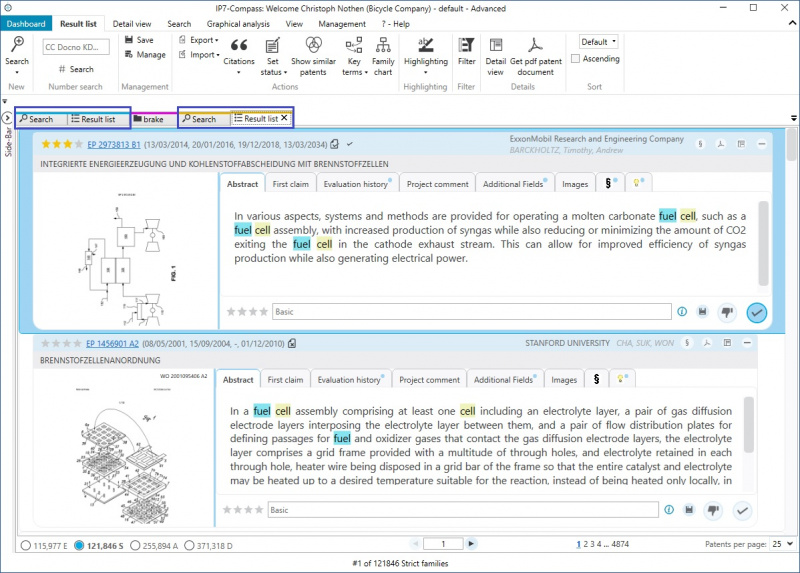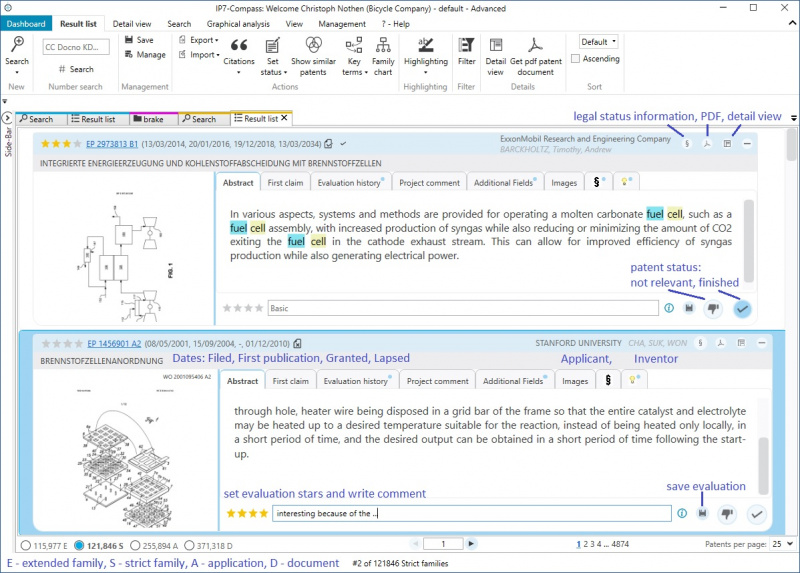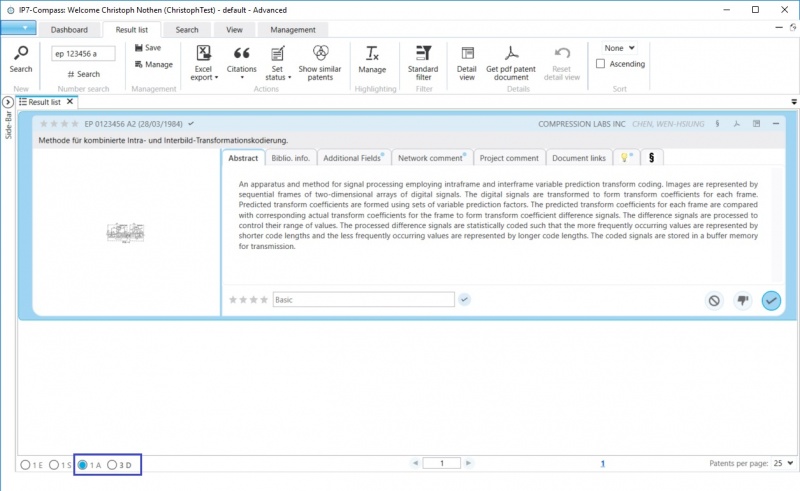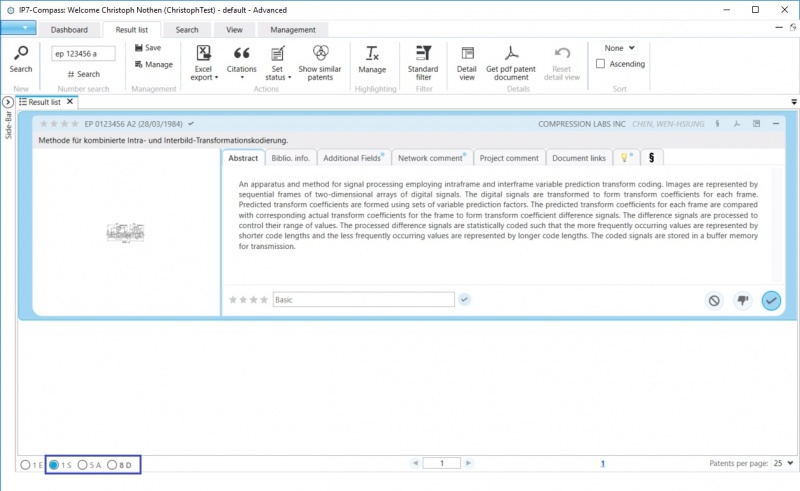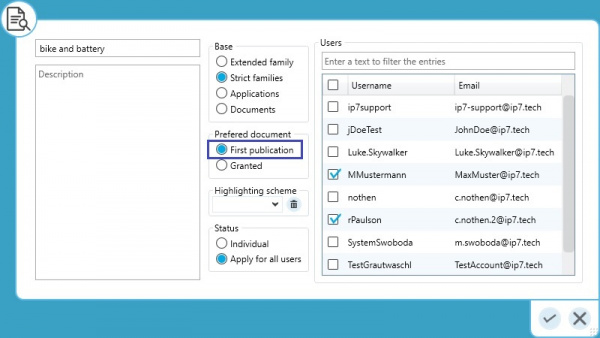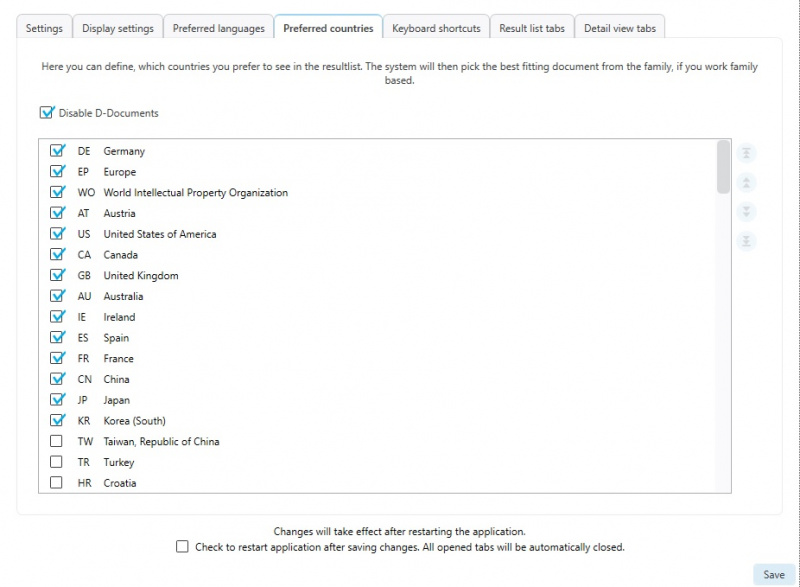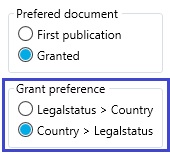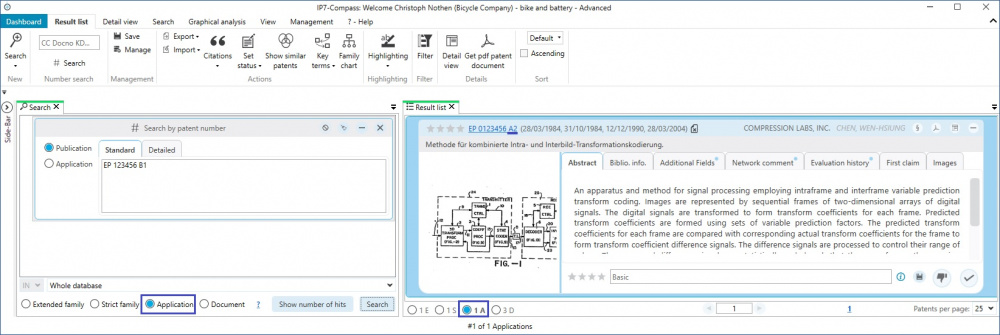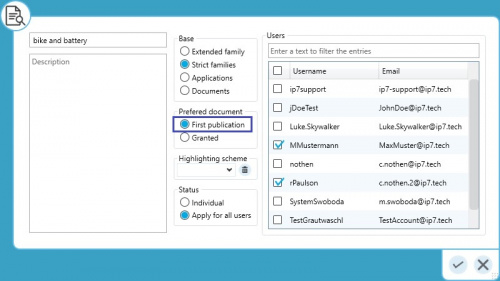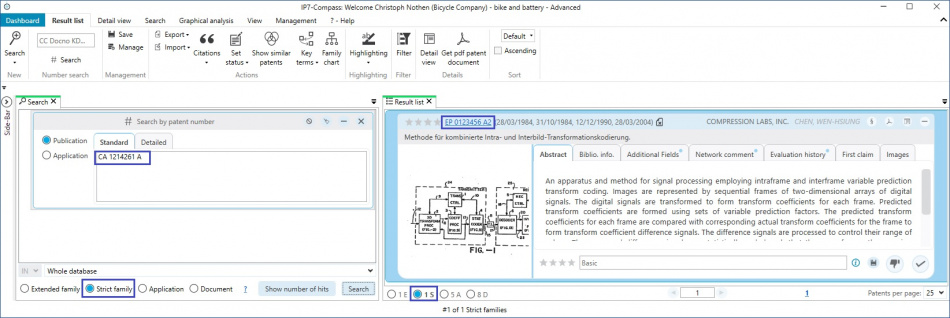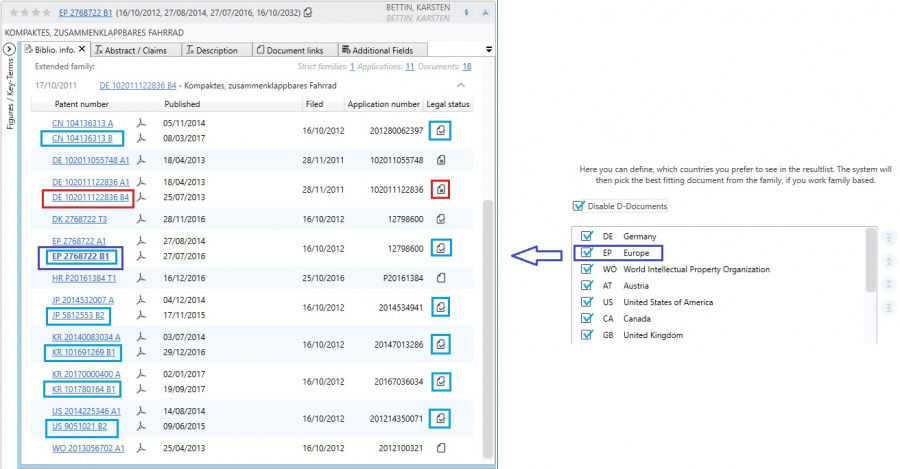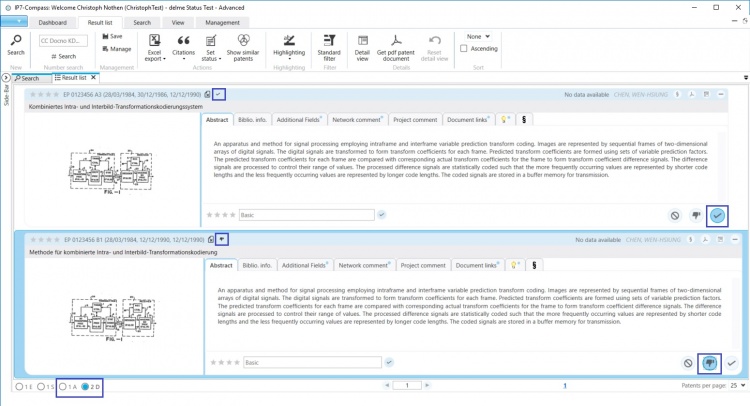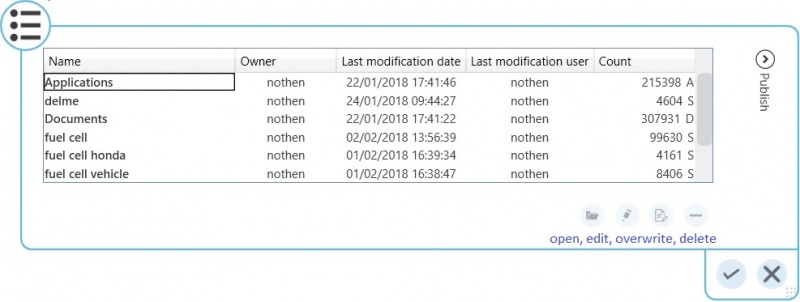EN:Result List: Difference between revisions
No edit summary |
|||
| (6 intermediate revisions by 2 users not shown) | |||
| Line 34: | Line 34: | ||
Hits can be grouped to a larger basis. <br /> | Hits can be grouped to a larger basis. <br /> | ||
E.g. from document to strict family - of the documents in the result only one representative per strict family is displayed <br /> | E.g. from document to strict family - of the documents in the result only one representative per strict family is displayed <br /> | ||
Or a smaller basis is selected. <br /> | Or a smaller basis is selected. <br /> | ||
| Line 40: | Line 39: | ||
'' 'Example number search according to EP 123456 A' '' <br /> | '''Example number search according to EP 123456 A''' <br /> | ||
The basis of the number search is always document. <br /> | The basis of the number search is always document. <br /> | ||
Therefore all EP-A documents are displayed (2D). <br /> | Therefore all EP-A documents are displayed (2D). <br /> | ||
| Line 47: | Line 46: | ||
If the basis is changed from D-Document to A-Application, only one document is displayed per application. | If the basis is changed from D-Document to A-Application, only one document is displayed per application. | ||
With the amount under "D", all 3 documents of the | With the amount under "D", all 3 documents of the application are now counted and therefore the number increases. <br /> | ||
The B document is now also counted. It was not found earlier because due to the restriction to A documents. <br /> | The B document is now also counted. It was not found earlier because due to the restriction to A documents. <br /> | ||
| Line 70: | Line 69: | ||
Which document from this strict family is displayed as a representative depends on the following two settings: <br/> | Which document from this strict family is displayed as a representative depends on the following two settings: <br/> | ||
1, '' 'Preferred Document' '' <br/> | 1, '''Preferred Document''' <br/> | ||
This setting is available for every [[EN:Projects|project]] and every task. <br/> | This setting is available for every [[EN:Projects|project]] and every task. <br/> | ||
Here you can select whether first publication or grant should be displayed as a preference. <br/> | Here you can select whether first publication or grant should be displayed as a preference. <br/> | ||
| Line 76: | Line 75: | ||
[[File:ProjectSetting.jpg|600px]] | [[File:ProjectSetting.jpg|600px]] | ||
2, '''[[ | 2, '''[[EN:Settings#Preferred_countries|Preferred country]]''' <br/> | ||
This setting is available for every user. <br/> | This setting is available for every user. <br/> | ||
Here an order - priority for the countries is set. <br/> | Here an order - priority for the countries is set. <br/> | ||
| Line 85: | Line 84: | ||
The logic for determining the representative is explained below: <br/> | The logic for determining the representative is explained below: <br/> | ||
1, The "preferred document" setting is set to: '' 'First publication' '' <br/> | 1, The "preferred document" setting is set to: '''First publication''' <br/> | ||
Step 1: The preferred | Step 1: The preferred application is determined from the strict family based on the "Preferred Country" setting. <br/> | ||
Step 2: The first publication is determined from this application. <br/> | Step 2: The first publication is determined from this application. <br/> | ||
| Line 93: | Line 92: | ||
Step 2: The preferred document is determined from the grants based on the "Preferred Country" setting. <br/> | Step 2: The preferred document is determined from the grants based on the "Preferred Country" setting. <br/> | ||
If the steps in the setting '''Grant''' (point 2) should be exactly the other way around, IP7 can enable an extended setting if desired.<br /> | |||
With this setting (Grant preference) you can choose from both options.<br /> | |||
[[File:GrantPreference.jpg|170px|]] | |||
"Legalstatus > Country" corresponds to point 2 <br /> | |||
"Country > Legal Status" corresponds to: | |||
Step 1: Preferred application is determined from the strict family based on the "Preferred Country" setting.<br/> | |||
Step 2: The grant is determined from this application preferred. (if no grant exists, the first publication is displayed)<br/> | |||
The folders or folder assignments are an exception to this logic. <br/> | The folders or folder assignments are an exception to this logic. <br/> | ||
| Line 151: | Line 160: | ||
The DE B4 document will not be considered because it is already "dead". <br /> | The DE B4 document will not be considered because it is already "dead". <br /> | ||
== Status of a patent == | == Status of a patent == | ||
| Line 221: | Line 205: | ||
[[File:ExcelExportWholeRes.jpg|100px]] | [[File:ExcelExportWholeRes.jpg|100px]] | ||
== Sorting == | |||
[[File:ResultListSortMenuOpen.jpg|right|180px]] | |||
A result list can basically be sorted according to the following criteria: <br/> | |||
* '''Filed''' - filed date (for base A or D) | |||
* '''Priority''' - priority date | |||
* '''First publication''' - first publication date | |||
For these first 3 criteria, the [[EN:Result_List#Basis_of_the_result_list|basis of the results list]] is decisive.<br/> | |||
e.g. First publication <br/> | |||
D - publication date <br/> | |||
A - first publication of the application <br/> | |||
S - first publication of the strict family <br/> | |||
E - first publication of the extended family <br/> | |||
* '''Patent number''' - Alphabetical sorting by patent number | |||
* '''Applicant''' - Alphabetical sorting by applicant name | |||
* '''Reference Ranking''' - Citation ranking - Patents that are most frequently cited by patents from the same result list are sorted up | |||
* '''First opposition date''' - this allows patents for which the opposition period expires first to be sorted upwards | |||
Additional criteria for sorting when a folder is opened: | |||
* '''Assignment date''' - sorting by assignment date (when was the patent/family assigned to the folder) | |||
* '''Assignment user''' - Alphabetical sorting by username (who assigned the patent/family to the folder) | |||
Additional criteria for sorting when a monitoring task has been opened: | |||
* '''Monitoring Task assignment''' - sorting by date of assignment (when was the patent/family assigned to the monitoring task) | |||
The '''default''' sorting depends on how a result list was created: | |||
* Open folder -> no sorting -> random | |||
* Show search results with at least one full-text search -> [[EN:Text_search#Full_text_ranking|full text ranking]] | |||
* Show search results without a full-text search -> citation ranking | |||
* Search results from number search or number import -> same order as specified in the search | |||
If a list of results is opened via the dashboard by clicking on the patent status (new/finished/not relevant), then the list is sorted according to citation ranking/"reference ranking". <br/> | |||
This applies to monitoring tasks, ad hoc tasks, folder monitoring and search projects. <br/> | |||
== Save/open/manage== | == Save/open/manage== | ||
Latest revision as of 15:46, 8 May 2024
The result list is used to display the results of performed searches and the contents of folders.
General
After carrying out a search a new tab automatically opens displaying the respective result list.
The search window and the corresponding result list are grouped and highlighted in the same colour.
It is possible to switch between the open tabs.
New tabs are opened when a new search is carried out.
Among other things, the result list is used to evaluate patents (Allocation of stars and comments).
Subsequently the status of a patent can be changed.
Initially all patents are set as "unread" and can then be changed to the status "not relevant" or "OK".
Basis of the result list
A basis is always given in the result list:
D-Document
A-Application
S-Strict family
E-Extended family
Which basis is originally selected in a result list depends on how this result list was created.
A result list can e.g. result from an executed search or when a folder is opened.
The original basis of the result list can be changed:
Hits can be grouped to a larger basis.
E.g. from document to strict family - of the documents in the result only one representative per strict family is displayed
Or a smaller basis is selected.
e.g. from strict family to document - all documents from the strict families are displayed
Example number search according to EP 123456 A
The basis of the number search is always document.
Therefore all EP-A documents are displayed (2D).
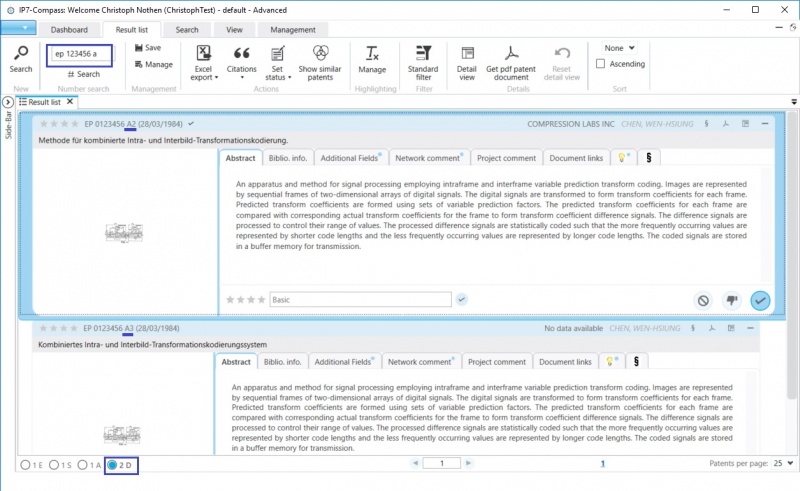
If the basis is changed from D-Document to A-Application, only one document is displayed per application.
With the amount under "D", all 3 documents of the application are now counted and therefore the number increases.
The B document is now also counted. It was not found earlier because due to the restriction to A documents.
When changing to S-strict family, all applications and documents of the strict family will be considered.
This increases the number of "A" and "D":
If you switch back to D-documents, not 8 documents are displayed, but only the 2 documents found in the original number search.
The result list never forgets the original basis and the original hits.
Therefore it is always displayed in bold.
(in this example: "D")
Basis and representative
For example, if a strict family search is performed, a representative of the strict family will be displayed in the results list.
Which document from this strict family is displayed as a representative depends on the following two settings:
1, Preferred Document
This setting is available for every project and every task.
Here you can select whether first publication or grant should be displayed as a preference.
2, Preferred country
This setting is available for every user.
Here an order - priority for the countries is set.
(the top selected country in the list has the highest priority to be displayed as a representative)
The logic for determining the representative is explained below:
1, The "preferred document" setting is set to: First publication
Step 1: The preferred application is determined from the strict family based on the "Preferred Country" setting.
Step 2: The first publication is determined from this application.
2, The "preferred document" setting is: Grant
Step 1: The living grants from the strict family are identified.
Step 2: The preferred document is determined from the grants based on the "Preferred Country" setting.
If the steps in the setting Grant (point 2) should be exactly the other way around, IP7 can enable an extended setting if desired.
With this setting (Grant preference) you can choose from both options.
"Legalstatus > Country" corresponds to point 2
"Country > Legal Status" corresponds to:
Step 1: Preferred application is determined from the strict family based on the "Preferred Country" setting.
Step 2: The grant is determined from this application preferred. (if no grant exists, the first publication is displayed)
The folders or folder assignments are an exception to this logic.
The folders have their own representative.
Examples
The following screenshots show the search on the left and the result of this search on the right.
Option: "Document"
Exactly one document (B document) was searched for and this document is displayed in the result list.
("1 D" - 1 document)
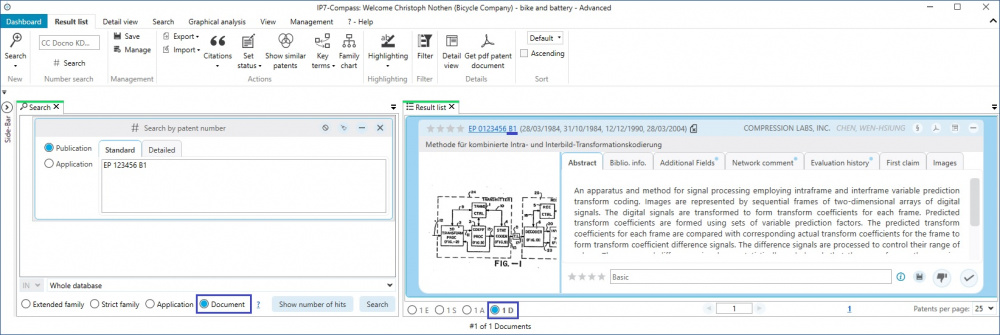
Option: "Application"
The search is performed via application and therefore applications are displayed in the result.
("1 A" - 1 application)
A total of 3 documents are summarized in this application.
("3 D" - 3 documents)
In this example the representative of this application is the A2 document, since the setting "preferred document" - first publication is selected.
Option: families (in this example "Strict family")
The setting "preferred document" is set to first publication.
The search is carried out using strict families and therefore strict families are displayed in the result.
("1 S" - 1 strict family)
The representative of this strict family in this example is again the EP A2 document.
In the "Preferred Country" setting, EP is placed in front of the CA entry.
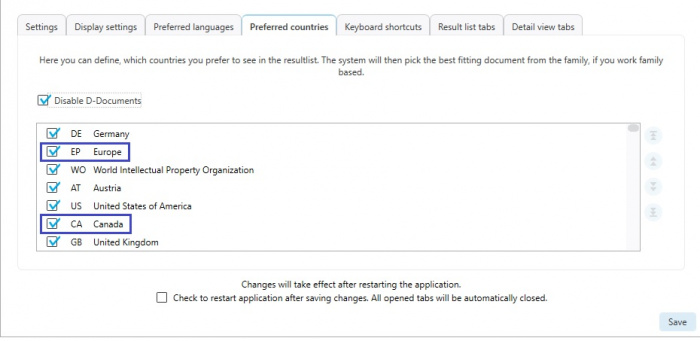
Another example of strict family
This time the setting "preferred document" is set to grant.
The search is again carried out using strict families and therefore strict families are displayed in the result.
("1 S" - 1 strict family)
The representative of this strict family in this example is the EP B1 document.
Step 1 - light blue: The living grants from the strict family are identified.
Step 2 - dark blue: The preferred document is determined from the grants based on the "Preferred Country" setting.
The DE B4 document will not be considered because it is already "dead".
Status of a patent
The following statuses are available (with increasing weighting):
- None (unread)
- not relevant (read)
- OK (read)
The status "not relevant" has a higher weighting than "None" and "OK" has the highest weighting.
All documents initially have the status "None".
In the result list the current status of a document is displayed to the right of the patent number in the result list.
If the status is "None", this field is left blank.
The 3 buttons for the allocation of the status, display the status of the currently selected document.
Example
As long as D - Documents is selected as a basis, all statuses can be displayed:
When changing to A - Application:
Now the highest status ("OK") is displayed next to the patent number.
The status "not relevant" is displayed during the status allocation, as the status of the representative is shown here.
The B-Document has the status "not relevant" and the B-Document is shown as the representative.
Select results
In the result list it is possible to select specific patents for the Word/Excel export.
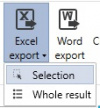
The selection supports the features of the Windows-Explorer:
With the shortcut Ctrl+A, all patents of the displayed page are selected.
Holding down the Shift-key and mouse click selects specific areas of patents.
Holding down the Ctrl-key and mouse click selects multiple specific patents.
Here, it is important that the mouse click takes place in the following areas:
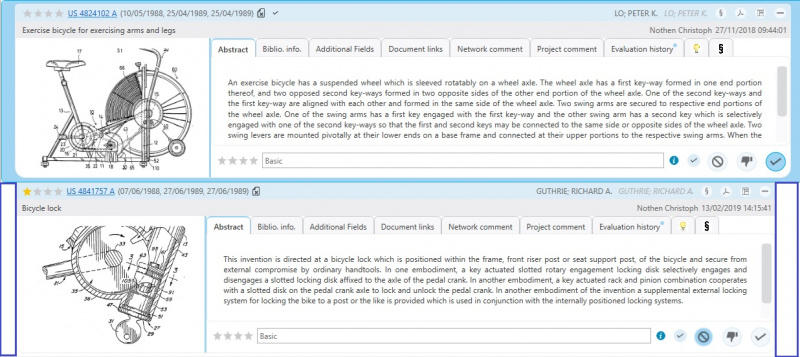
Obviously, it is also possible to select the entire result for the Excel export.
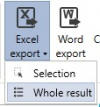
Sorting
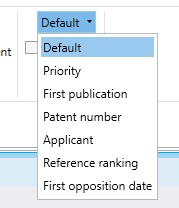
A result list can basically be sorted according to the following criteria:
- Filed - filed date (for base A or D)
- Priority - priority date
- First publication - first publication date
For these first 3 criteria, the basis of the results list is decisive.
e.g. First publication
D - publication date
A - first publication of the application
S - first publication of the strict family
E - first publication of the extended family
- Patent number - Alphabetical sorting by patent number
- Applicant - Alphabetical sorting by applicant name
- Reference Ranking - Citation ranking - Patents that are most frequently cited by patents from the same result list are sorted up
- First opposition date - this allows patents for which the opposition period expires first to be sorted upwards
Additional criteria for sorting when a folder is opened:
- Assignment date - sorting by assignment date (when was the patent/family assigned to the folder)
- Assignment user - Alphabetical sorting by username (who assigned the patent/family to the folder)
Additional criteria for sorting when a monitoring task has been opened:
- Monitoring Task assignment - sorting by date of assignment (when was the patent/family assigned to the monitoring task)
The default sorting depends on how a result list was created:
- Open folder -> no sorting -> random
- Show search results with at least one full-text search -> full text ranking
- Show search results without a full-text search -> citation ranking
- Search results from number search or number import -> same order as specified in the search
If a list of results is opened via the dashboard by clicking on the patent status (new/finished/not relevant), then the list is sorted according to citation ranking/"reference ranking".
This applies to monitoring tasks, ad hoc tasks, folder monitoring and search projects.
Save/open/manage
Depending on which unit/basis is selected in the current result, the result list is also saved with this setting.
The number of results also corresponds to the selected basis.
Publish result lists

Saved result lists can be shared with other users:
1 Open result lists
2 Select result list
3 Select user and assign permission in the drop down field
4 Click the Save button

